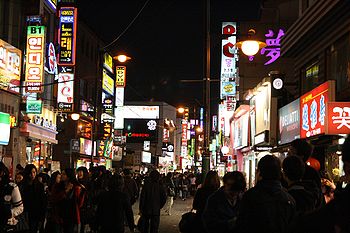- Daehangno
-
Daehangno (Hangul:대학로 Hanja:大學路, lit. "college street") is a neighborhood in Seoul north of the Han River within Jongno-gu and Seodaemun-gu.
Formerly known as Sunggyobang (Hangul:숭교방 Hanja:崇敎坊), meaning "high respect for teaching", its current name was designated when the 1.1km six-lane road from Hyehwa-dong (혜화동) rotary to Ihwadong (이화동 梨花洞) crossroad was designated as a "street of culture" on May 5, 1985.
Contents
Overview
Daehangno is the street from the crossroad of 79-1, Jongno 5-ga, Jongno-gu, to Hyehwadong rotary, 132, Hyehwa-dong. Its name was designated on May 5, 1985, when the street was designated as the “street of culture” representing the characteristics of this area. At the beginning, the section of 700m between Naksan Garden on Hyehwadong side and the Attached Middle School, College of Education, Seoul National University, was designated as a “street without cars” during 18:00 - 22:00 on Saturdays and 12:00 - 22:00 on Sundays and holidays. Daehangno was originally the road of 3.1km in length from Jangchung Park, 187, Jangchung-dong, to Ssangnim-dong and Ihwa-dong. But, when deciding the name of the street on November 7, 1984, the section between the crossroad of Jongno 5-ga and Jangchung Park was separated from Daehangno as Hunlyeonwon road by the subdivision policy of downtown section. It was originally 25m in width, but expanded to 40m from Ihwadong crossroad to Hyehwadong rotary, owing to the construction of the Seoul Subway Line 4.
This was an area where college students and the youth used to gather as College of Chemistry and College of Law, Seoul National University, were located in this area. But, when Seoul National University moved near Gwanaksan in 1975, Marronnier Park was formed in the area, and many cultural art organizations related to play, movie, concert and musical moved in.
Outdoor performance stage and playing ground on the road plaza located in front of the Korean Culture and Arts Foundation attract the young generation for outdoor concert, recitation of poem, play and the like.
Major passage areas are Myeongnyun-dong, Yeonji-dong, Hyoje-dong, Ihwa-dong, Dongsung-dong and Yeongeon-dong in Jongno-gu. Daehangno is connected to Changgyeonggungno, Dongsomunno and Jongno, and a convenient place with Hyehwa station of the subway line No 4 and Jongno 5-ga station of Seoul Subway Line 4.
Cultural art organizations such as the Artistic and Cultural Foundation of Korea, the Korean Culture and Arts Foundation, Dongsoong Art Gallery, Art Hall, Samtoh’s Blue Bird Theater, Daehangno Theater, Marronnier’s Small Theater and Grand Theater of the Literary Hall, including educational institutes such as the Attached Elementary School and Middle School of the College of Education, Seoul National University, Korea National Open University and Hyoje Elementary School, and public institutions such as Hyoje Tax Office, Korea International Cooperation Agency, National Institute for International Education Development, Jungbu District Office of Education and Hyehwa Telephone Office, are all located in this area.
In addition, Heungsadahn, Korea Institute of Design Promotion, Eehwa Wedding Hall, Memorial Hall for 100th anniversary of the Korean Christianity, Christianity Hall and Catholic Youth Hall, and Eehwajang, the remains of the Joseon Dynasty and historical monument No 6 of Seoul, are all located in this area.
History
Seonggyungwan, Industrial Polytechnic Institute, National Hospital, Keijo Imperial University naming of Sunggyobang (the origin of Dongsungdong) are standing as the center of learning.
Name of Gyeongseong Imperial University was changed to Seoul National University, which was moved near to the Gwanak Mountain in 1975, and the road of College of Liberal Arts and Sciences and Marronnier Park were formed, which made the area as a potential crime-ridden district.
Moving of Seoul National University led the opening of the Art Gallery and Art Theater of the Literary Hall and development of cultural space by Mr. Soo-Geun Kim in the same area.
Operation of the city plan attracted the moving population on Daehangno being increased gradually.
Tourism
Designation of the name Daehangno, and management and discontinuance of the “street without cars” brought an increase in the number of small theater (establishment of 13 small theaters) and degenerated cultural space for the youth, which was a valuable space for the young culture.
Marronnier Park was activated as the renovation work for street environment was pursued, and small theaters were getting crowded so as to attract the increase of the appearance of commercial drama. All these movements are for the space of performing culture.
Review and preparation on the designation of the area as cultural area will bring the increase of performance space and commercialization and the decrease of performing culture by expenditure space being increased. Movement of art-related colleges to Daehangno is being increased. All these movements will bring the attention on the formation of cultural area.
- Places to eat near Marronier
There are many places to eat throughout the Daehangno area. This theater and art district has many lovely restaurants to for people looking for a special place to eat. One can choose from such foods as Korean, Chinese, western-style, or even fusion-style restaurants. TGI Fridays and Bennigan's are just two of the famous western-style restaurants that are sure to please those craving American food.
- Places to eat near Sungkyunkwan University
Inexpensive dining options are across the street from the Marronier Park area and head towards subway line 4, exit 4 to find an alley lined with affordable yet tasty restaurants.
Transportation
• Location : 79-1, Jongno 5-ga, Jongno-gu, Seoul • Seoul Subway Line 4 to Hyehwa Station.
External links
- Daehangno– Seoul’s Theater District: Official Seoul City Tourism
- Daehakno (University Avenue) Article]
- Jongno-gu local government website
- Tour2Korea
- Article by Seoul City Government
Districts of Seoul 
North of Han River South of Han River Neighbourhoods of Seoul Categories:- Jongno-gu, Seoul
- Streets in Seoul
- Geography of South Korea
- Neighbourhoods of Seoul
Wikimedia Foundation. 2010.

